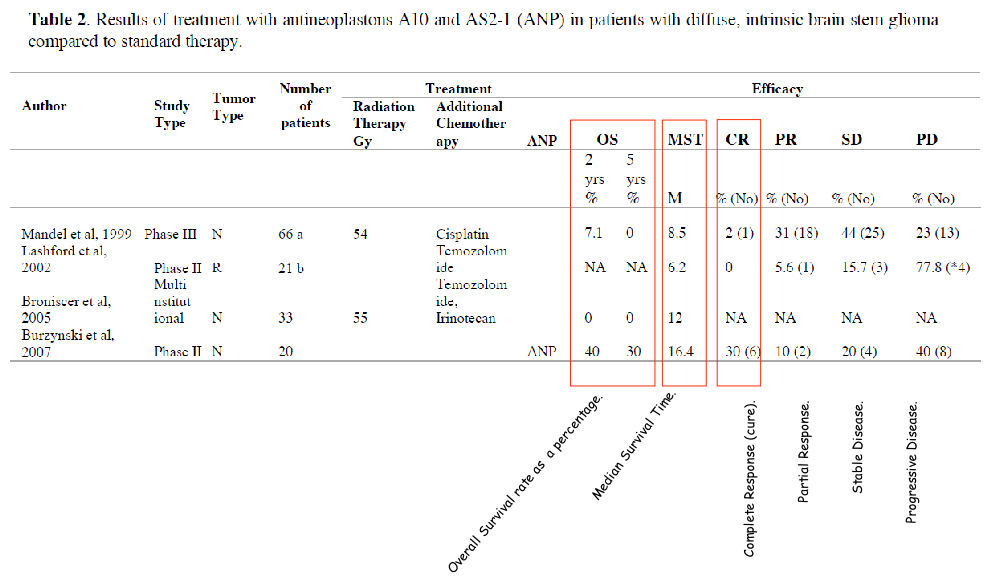From “Recent clinical trials in diffuse intrinsic brainstem glioma” by Stanislaw R.Burzynski in Cancer Therapy Volume 5, 379-390, 2007.
The table summarizes standard treatments versus Dr. Burzynski’s, given at the bottom. The red boxes outline the core situation, overall survival rate for 2 and 5 years, median survival time, and cure rate. One way to summarize this would be: under standard treatment DBSG is always fatal; under the Burzynsky treatment there is a 30% cure rate. However, the standard treatment does show one patient as cured despite 0 patients surviving 5 years. That doesn’t much change my summary. The Median Survival Time may be confusing until you realize that it is given in months, not years. That would be the months required for only half of the patients to still be alive.
Eric Merola, director of the documentary I have referred to earlier (Burzynski: Cancer is Serious Business) is evidently a fierce student of the medical literature. In his comment on the refusal of the White House to answer his petition  to have the results of Burzynski’s phase II trials acknowledged by the FDA and audited by the Congress (the White House had the FDA answer), he looks at the accelerated approval the FDA granted to Avastin based on type 2 studies, comparing that to its refusal even to acknowledge Burzynski’s type 2 results. I find the comparison of great interest and publish part of it here:
to have the results of Burzynski’s phase II trials acknowledged by the FDA and audited by the Congress (the White House had the FDA answer), he looks at the accelerated approval the FDA granted to Avastin based on type 2 studies, comparing that to its refusal even to acknowledge Burzynski’s type 2 results. I find the comparison of great interest and publish part of it here:
Avastin (breast cancer) 2008: The FDA granted accelerated approval for Avastin in the treatment of advanced breast cancer in 2008. The results that allowed it to be “accelerated”: Only 11.3 months of “Progression-free survival”. [10]
The FDA took it off the market for this condition in November 2011 because it doesn’t work at all if not properly prescribed [11] …. But don’t feel bad for the company that owns it, they made their fortune from it already for this condition, making up for 17% of the entire company's sales. [12]
Avastin (Glioblastoma brain cancer) 2009: The FDA granted accelerated approval for this medicine for Glioblastoma. The FDA’s reasoning was “People with this type of brain cancer have had no new treatments in more than a decade”. [13] Well, what about “brainstem glioma” patients? They haven’t had a new treatment for that condition—ever. But it gets better. Only 58 patients were treated in a single Phase 2 study. The median “response duration” was a mere 3.9 months. That is a “response”, not a cure, or even any real extension of life at all. Antineoplastons have a 30% cure rate in "brainstem glioma", not a “response rate”. During this single Phase 2 arm of 58 patients that got Avastin accelerated approval for Glioblastoma—none of them were cured.
As the White House presented it, my emphasis: “Antineoplastons are gene-targeted cancer medications that have completed Phase 2 FDA clini-cal trials in 2009, with permission granted to enter the final Phase of FDA testing. These medi-cines are the first in medical history to cure inoperable childhood brainstem glioma with a 27.5%-50% cure rate, among other cures. Other gene-targeted cancer medications have been given accelerated FDA-approval without demonstrating a single cure. Antineoplastons, proven to be non-toxic, remain unapproved for public use. For the sake of public health, the results from Phase 2 clinical trials of Antineoplastons need to be publicly acknowledged by the FDA and audited by Congress. These medicines have been in FDA clinical testing since 1995—it's time for the general public to have access to them.”


 to have the results of Burzynski’s phase II trials acknowledged by the FDA and audited by the Congress (the White House had the FDA answer), he looks at the accelerated approval the FDA granted to Avastin based on type 2 studies, comparing that to its refusal even to acknowledge Burzynski’s type 2 results. I find the comparison of great interest and publish part of it here:
to have the results of Burzynski’s phase II trials acknowledged by the FDA and audited by the Congress (the White House had the FDA answer), he looks at the accelerated approval the FDA granted to Avastin based on type 2 studies, comparing that to its refusal even to acknowledge Burzynski’s type 2 results. I find the comparison of great interest and publish part of it here:

